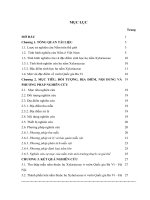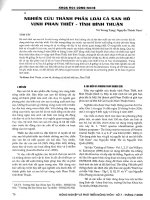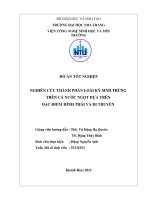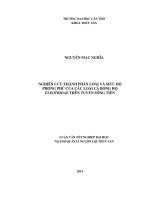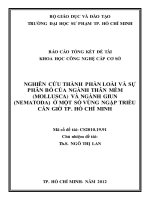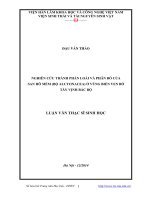Nghiên cứu thành phần loài của liên họ bọ xít nước corixoidea (insecta heteroptera) tại việt nam
Bạn đang xem bản rút gọn của tài liệu. Xem và tải ngay bản đầy đủ của tài liệu tại đây (2.95 MB, 122 trang )
ĐẠI HỌC QUỐC GIA HÀ NỘI
TRƯỜNG ĐẠI HỌC KHOA HỌC TỰ NHIÊN
Hà Tuyết Ngân
NGHIÊN CỨU THÀNH PHẦN LOÀI CỦA LIÊN HỌ BỌ XÍT NƯỚC
CORIXOIDEA (INSECTA: HETEROPTERA) TẠI VIỆT NAM
THE STUDY ON THE WATER BUG FAUNA OF THE SUPERFAMILY
CORIXOIDEA (INSECTA: HETEROPTERA) IN VIETNAM
LUẬN VĂN THẠC SĨ KHOA HỌC
Hà Nội - 2020
ĐẠI HỌC QUỐC GIA HÀ NỘI
TRƯỜNG ĐẠI HỌC KHOA HỌC TỰ NHIÊN
Hà Tuyết Ngân
NGHIÊN CỨU THÀNH PHẦN LOÀI CỦA LIÊN HỌ BỌ XÍT NƯỚC
CORIXOIDEA (INSECTA: HETEROPTERA) TẠI VIỆT NAM
THE STUDY ON THE WATER BUG FAUNA OF THE SUPERFAMILY
CORIXOIDEA (INSECTA: HETEROPTERA) IN VIETNAM
Chuyên ngành: Động vật học
Mã số: 8420101.03
LUẬN VĂN THẠC SĨ KHOA HỌC
NGƯỜI HƯỚNG DẪN KHOA HỌC:
PGS.TS. Trần Anh Đức
XÁC NHẬN HỌC VIÊN ĐÃ CHỈNH SỬA THEO QUYẾT NGHỊ CỦA HỘI ĐỒNG
CHẤM LUẬN VĂN THẠC SĨ
Chủ tịch hội đồng chấm luận văn
Giáo viên hướng dẫn
thạc sĩ khoa học
PGS.TS. Nguyễn Văn Vịnh
Hà Nội - 2020
PGS.TS. Trần Anh Đức
ACKNOWLEDGEMENTS
I would like to express my sincere gratitude to my thesis supervisor, Assoc. Prof. Trần Anh
Đức. He consistently allowed this thesis project to be my own work, but steered me in the
right the direction whenever he thought I needed it. I have also received many valuable
advices from him.
Besides, I would also like to thank all staff and students in Department of Applied
Zoology. Without their passionate participation and comments, this thesis could not have
been completed.
I express my deep sense of gratitude to to Assoc. Prof. Nguyễn Lai Thành for granting
access to high magnification microscopic equipment in his laboratory at Center for Life
Science Research, Dr. Nguyễn Thanh Sơn for guiding me the techniques of photographing
habitus of small-sized insects like Micronectidae.
My sincere thanks also extend to Assoc. Prof. Nguyễn Văn Vịnh for facilitating some field
trips and Dr. Hwang Wei Song (Lee Kong Chian Natural History Museum, National
University of Singapore) for the loan of micronectid specimens.
I am extremely grateful to the Nagao Natural Environment Foundation Scholarship for
funding my MSc study and field trip.
I acknowledge with thanks the kind of patronage and enthusiastic, considerate support,
which I have received from Mr. Bùi Văn Hoàng when I was in field trip to southern
Vietnam.
Last but not least, I must express my very profound gratitude to my family and friends who
always support and encouraged me throughout this long journey of learning.
This study is supported by the Vietnam Ministry of Science and Technology, under project
number ĐTĐL.CN-65/19.
Hanoi, December 2020
Hà Tuyết Ngân
TABLE OF CONTENTS
INTRODUCTION ................................................................................................ 5
Chapter 1. LITERATUTE REVIEW ..................................................................... 7
1.1. An overview of taxonomical research on the superfamily Corixoidea in
Asia.................................................................................................................................... 7
1.2. An overview of taxonomical research on the superfamily Corixoidea in
Vietnam ............................................................................................................................ 8
1.3. Some information about natural conditions of Vietnam ...................................... 9
Chapter 2. MATERIALS AND METHODS ......................................................... 11
2.1. Materials.................................................................................................................. 11
2.2. Methods ................................................................................................................... 13
2.2.1 Collecting and preservation methods ................................................................. 13
2.2.2 Preparation of microscopic slide ........................................................................ 13
2.2.3 Identification of specimens ................................................................................ 13
2.2.4 Habitus and illustrations of morphological characters ....................................... 14
Chapter 3. RESULTS AND DISCUSSION ........................................................... 16
3.1. Classification and key to current subgenera of Micronecta ............................... 16
3.2. Species composition of the superfamily Corixoidea in Vietnam ........................ 25
3.3. Diagnostic features of species of Micronectidae occurring in Vietnam............. 33
3.3.1. Diagnoses of species of Micronectidae ............................................................ 33
3.3.2. Key to currently known species of Micronecta in Vietnam ............................. 79
3.4. Diagnostic features of species of Corixidae occurring in Vietnam .................... 86
CONCLUSIONS ................................................................................................ 92
REFERENCES .................................................................................................. 93
APPENDIX ...................................................................................................... 100
Material examined ............................................................................................ 101
1
LIST OF FIGURES
Figure 1: Geographic (A) and climatic (B) regions of mainland Vietnam .......................... 10
Figure 2: Schematic map of sampling areas of Corixoidea in Vietnam .............................. 12
Figure 3: Morphological structures for the identification of Corixoidea (reproduced from
Chen et al., 2015: Figs. 6, 7, 8, 10) ............................................................................. 15
Fig. 4. Habitus photos of species of Micronecta Kirkaldy, 1897b ...................................... 36
Fig. 5. Morphological features of Micronecta species, ♂♂ ................................................ 37
Fig. 6. Morphological features of Micronecta species, ♂♂ ................................................ 40
Fig. 7. Morphological features of Micronecta species, ♂♂ ................................................ 42
Fig. 8. Habitus photos of species of Micronecta Kirkaldy, 1897b, ♂♂ .............................. 43
Fig. 9. Morphological features of Micronecta species, ♂♂ ................................................ 46
Fig. 10. Morphological features of Micronecta species, ♂♂ .............................................. 48
Fig. 11. Morphological features of Micronecta spA.n., ♂ .................................................. 49
Fig. 12. Morphological features of Micronecta species, ♂♂ .............................................. 51
Fig. 13. Morphological features of Micronecta spF.n., ♂ ................................................... 53
Fig. 14. Morphological features of Micronecta spK.n., ♂ .................................................. 54
Fig. 15. Morphological features of Micronecta spB.n., ♂................................................... 55
Fig. 16. Habitus photos of species of Micronecta Kirkaldy, 1897b, ♂♂ ............................ 56
Fig. 17. Morphological features of Micronecta species., ♂♂ ............................................. 58
Fig. 18. Morphological features of Micronecta spC.n., ♂................................................... 60
Fig. 19. Morphological features of Micronecta spH.n., ♂ .................................................. 61
Fig. 20. Morphological features of Micronecta spG.n., ♂ .................................................. 62
Fig. 21. Morphological features of Micronecta spD.n., ♂ .................................................. 64
Fig. 22. Morphological features of Micronecta spE.n., ♂ ................................................... 65
Fig. 23. Morphological features of Micronecta haliploides Horváth, 1904, ♂ ................... 67
Fig. 24. Habitus photos of species of Micronecta Kirkaldy, 1897b and Synaptonecta
Lundblad, 1933b, ♂♂ ................................................................................................. 70
Fig. 25. Morphological features of Micronecta species, ♂♂ .............................................. 71
Fig. 26. Morphological features of Micronecta species, ♂♂ .............................................. 73
Fig. 27. Morphological features of Micronecta spI.n., ♂ .................................................... 75
Fig. 28. Morphological features of Micronecta species, ♂♂ .............................................. 77
2
Fig. 29. Morphological features of Synaptonecta issa (Distant, 1910), ♂. ......................... 79
Fig. 30. Habitus photos of species of Agraptocorixa Kirkaldy, 1898 and Sigara Fabricus,
1775, ♂♂ ..................................................................................................................... 88
Fig. 31. Morphological features of Sigara septemlineata Paiva, 1918, ♂ ......................... 89
Sigara sp.1 ........................................................................................................................... 90
Fig. 32. Morphological features of Sigara sp.1, ♂ .............................................................. 91
A. Fore leg. B Strigil. C. Right paramere. D. Left paramere. .............................................. 91
LIST OF TABLES
Table 1: List of Corixoidea species currently known in Vietnam ....................................... 26
3
ABBREVIATIONS
a.s.l. = above sea level
Fig. = Figure
leg.= legit (collector)
National Park = N.P.
NHMW = Natural History Museum, Vienna, Austria
Prov. = Province
ZRC = Zoological Reference Collection, Lee Kong Chian Natural History Museum,
National University of Singapore, Singapore
ZVNU = Zoological Collection of Biological Museum, VNU University of Science,
Hanoi, Vietnam
4
INTRODUCTION
Water bugs of the superfamily Corixoidea (infraorder Nepomorpha) have
some significant ecological roles and economic importance. Species of Corixidae
are known to be important part in the diet of insectivorous fishes, amphibians, and
birds. Corixidae and Micronectidae are also a part of the freshwater
macroinvertebrate assemblage which is used as biological indicators [48].
The
superfamily
Corixoidea
consists
of
three
families,
Corixidae,
Micronectidae, and Diaprepocoridae. Diaprepocoridae only occurs in Australia and
New Zealand. Corixidae widely distribute in temperate regions and Micronectidae
is commonly found in tropical Asia [4]. In Southeast Asia, species of Micronectidae
are more commonly than those of Corixidae. Due to many structural similarities
with Corixidae, Micronectinae was originally established as a subfamily of
Corixidae by Jaczewski (1924) and followed by most subsequent entomologists
[23]. Nieser (2002b) pointed out key characters to support the distinction between
Corixidae and Micronectidae, and this classification has been largely accepted in
subsequent studies (e.g., Tinerella 2008, 2013; Chen et al. 2015) [8, 42, 56, 57].
Regarding the genus Micronecta, there have been several subgenera established
under this genus [8, 21, 46, 59, 62]. However, literature on this topic has been rather
scattered and diagnostic features of each subgenus were not well-defined, making it
difficult to interpret for subsequent workers. There is a need to re-evaluate
subgeneric classification of Micronecta.
The fauna of Micronectidae in Vietnam was mostly studied by Wróblewski
during 1962–1972, and his works are still the most complete research on this family
up to now. He reported and described 16 species from Vietnam (mostly in northern
area [59, 62]. Nieser (2000) described one more new species for Vietnam, M.
polhemusi [40]. Thus, prior to the present study, Wróblewski (1962, 1967, 1972a)
and Nieser (2000) recorded a total of 17 micronectid species from Vietnam [59, 62,
65]. Jaczewski (1962) reported Agraptocorixa hyalinipennis and four species of
5
genus Sigara on the family Corixidae from Vietnam [24]. In general, the knowledge
of Corixoidea in Vietnam is rather sparse and scattered in some literature about
aquatic bug fauna, thus needs to be investigated further.
Considering the points highlighted above, the study in this thesis, titled “The
study on the water bug fauna of the superfamily Corixoidea (Insecta:
Heteroptera) in Vietnam” has been carried out with the following objectives:
- To re-evaluate the classification of current subgenera of Micronecta.
- To investigate the species composition of Micronectidae and Corixidae
(superfamily Corixoidea) in Vietnam.
- To study diagnostic features of corixoid species and to construct a key to species
of the genus Micronecta in Vietnam.
6
Chapter 1. LITERATUTE REVIEW
1.1. An overview of taxonomical research on the superfamily Corixoidea in Asia
In Southeast Asia, the superfamily Corixoidea are represented by two
families, Corixidae (water boatmen) and Micronectidae (pygmy water boatmen).
Micronectidae was formerly recognized as a subfamily of Corixidae due to
their morphological similarities, e.g., triangular rostrum, spoon-shaped pala, middle
tarsi with very long claws, etc. Although these two families look very similar, they
clearly differ in several characteristics. The distinct characteristics of pygmy water
boatmen are the small size (1.0–5.0 mm), the exposed scutellum. In contrast to
Micronectidae, members of Corixidae are small to medium- sized (3-15 mm) with
the scutellum hidden under pronotum. [55]
Corixidae have the largest number of species of the Nepomorpha families
divided into four subfamilies, 450 species within 32 genera. Corixidae is an
exceptional family as they are most richly represented in temperate regions whereas
other Nepomorphan families are richest in tropical areas [4]. They are also the only
one that are omnivores while all aquatic bugs are predaceous. In Singapore, there
have been reports of only one species, Agraptacorixa hyalinipennis, while in
Peninsular Malaysia, only Sigara paivai has been found [55].
Unlike Corixidae, the family Micronectidae, especially the genus
Micronecta, are speciose in tropical Asia [55]. However, due to their tiny size and
unresolved classification, the micronectid fauna remains poorly studied, and is still
big gap of knowledge. In Southeast Asia, there occur only two genera of
Micronectidae, Micronecta Kirkaldy, 1897b and Synaptonecta Lundblad, 1933b.
They are closely related, but there are significant structural differences between the
two genera, as summarised by Wróblewski (1972a), Nieser (2002b), and Chen et al.
(2005). Wróblewski (1968) provided a checklist to Oriental species, with
distribution data of 43 micronectid species [63]. Nieser (2000) provided a key to 24
species of Micronectidae from Southeast Asia, but his study emphasised on the
7
fauna of Thailand [40]. Nieser (2002b) reviewed the Micronectidae from Peninsular
Malaysia and Singapore, reporting 20 species, of which 19 was Micronecta [42].
Subsequently, Nieser et al. (2004) described two more Micronecta species for
Thailand fauna [45]. However, there is the lack of comprehensive data from
remaining Southeast Asian countries, e.g., Laos, Cambodia, Myanmar. Very little is
known about the micronectid fauna in these countries.
1.2. An overview of taxonomical research on the superfamily Corixoidea in
Vietnam
In Vietnam, micronectid fauna was still inadequately explored. The fauna of
Micronectidae in Vietnam was mostly studied by Wróblewski during 1962–1972,
and his works are still the most complete research on this family up to now. He
reported and described 16 species from Vietnam (mostly in northern area),
including M. altera Wróblewski, 1972a, M. anatolica Lindberg, 1922, M. desertana
Distant, 1920, M. guttatostriata Lundblad, 1933b, M. jaczewskii Wróblewski, 1962,
M. khasiensis Hutchinson, 1940, M. ludibunda, M. pocsi Wróblewski, 1967, M.
punctata (Fieber, 1844) [= M. haliploides Horváth, 1904], M. quadristrigata, M.
scutellaris Stål, 1858, M. sedula Horváth, 1905, M. siva (Kirkaldy, 1897a), M.
tarsalis Chen, 1960, M. thyesta Distant, 1911 [= M. grisea (Fieber, 1844)] and
Synaptonecta issa (Distant, 1910) [62, 65].
Nieser (2000) described one more new species for Vietnam, M. polhemusi
[40]. Thus, prior to the present study, Wróblewski (1962, 1967, 1972a) and Nieser
(2000) recorded a total of 17 micronectid species from Vietnam.
Water boatmen species in Vietnam was only collected in some northern
mountainous provinces making the research on this species even less than on
Micronectidae. The most comprehensive work on Corixidae from Vietnam was
conducted by Jaczewski (1962), recorded five species of two genera: Agraptocorixa
hyalinipennis Fabricius, 1803, Sigara septemlineata Paiva, 1918, S. parvula
Matsumura, 1905 (= S. formosana Matsumura, 1915), S. distorta Distant, 1910, S.
connexa Lundblad, 1933b [= S. paivai Lundblad, 1928] [24].
8
1.3. Some information about natural conditions of Vietnam
Vietnam, a Southeast Asia country with a total land area approximately
330,591 km2, located from latitudes 827‟ and 2323‟N to longitudes 10208‟ and
10930‟E. The country borders China to the north, Laos and Cambodia to the west
and the East Sea to the east, south and southwest. [51]
Vietnam has a complex system of rivers, streams, ditches with the main
supply from rainwater. Therefore, along with the rainy season, the water level also
changes twice per year. This country has about 2,360 perennial rivers and streams
with over 10 km in length and nine major river systems. Two largest river systems
and also delta are the Red River in the north and the Mekong River in the south.
They differ greatly in their hydrology, in the timing and extent of flooding, in their
floral and fauna communities. However, these two delta are all heavily populated
and largely agricultural. On the mainland, Vietnam is devided into eight natural
geographical regions: Northeast,
Northwest, Red River Delta, North Central
Coast, Central Highlands, South Central Coast, Southeast, MeKong Riverdelta
(Fig 1A). [51]
Vietnam near the intersection of the tropical and temperate zones so the
temperatures are strongly seasonal and subtropical (Fig 1B), especially in the
interior with two main seasons: a dry, cool winter and warm, wet summer. Climate
not only plays a vital role to flowing direction in marine are but also affects the
plant and animal communities in each area. Based on geographic and climatic
conditions,
there
are
seven
different
climatic
regions
in
Vietnamese
mainland: Northwest, Northeast, North Delta (Red River Delta), North Central
(North Central Coast), South Central (South Central Coast), Central Highlands, and
the South. [51]
Lies north of Wallacea- a well-known area of biotic transition, Vietnam is
the intersection of many different plant and animal communities found in Asia and
Australia. Tropical flora and fauna in the East limestone mountains of North
9
Vietnam resembles South China. The central region has descending Chinese
elements, in contrast, the tropical factor gradually increases from the North to the
South. Truong Son Range in central Vietnam is a transitional region between
subtropical and tropical climate, it harbors mixed fauna (from the North and the
South) and many endemic species. Therefore, the scope and extent of transition
depends on the results of the study of each group of animals. [51]
Figure 1: Geographic (A) and climatic (B) regions of mainland Vietnam
10
Chapter 2. MATERIALS AND METHODS
2.1. Materials
The specimens examined in this study were collected by the staff and
students of the Department of Applied Zoology, Faculty of Biology, VNU
University of Science and loaned from Lee Kong Chian Natural History Museum
(National University of Singapore). All specimens were collected in several field
trips throughout Vietnam during 2001–2020. The specimens were collected from 25
provinces of Vietnam are shown in Figure 2 respectively and listed below:
Lao Cai
Nghe An
Ha Giang
Ha Tinh
Cao Bang
Quang Binh
Bac Kan
Quang Nam
Lang Son
Thua Thien Hue
Phu Tho
Binh Dinh
Vinh Phuc
Lam Dong
Quang Ninh
Ninh Thuan
Ninh Binh
Ho Chi Minh
Hoa Binh
Dong Nai
Hanoi (urban areas and Ba Vi)
Binh Thuan
Thanh Hoa
Ca Mau
Ba Ria Vung Tau (Con Dao island)
11
Figure 2: Schematic map of sampling areas of Corixoidea in Vietnam
12
2.2. Methods
2.2.1 Collecting and preservation methods
Corixoidea species were collected with hand nets by sweeping over the water
surface combinded with kicking/ stirring the bottom and side substrates.
Samples from the field were preserved in 90% ethanol, then transferred to
70% ethanol and stored mostly in the Zoological Collection of Biological Museum,
VNU University of Science, Hanoi, Vietnam. Some of specimens are to deposited
in the Natural History Museum, Vienna, Austria.
2.2.2 Preparation of microscopic slide
Genital structures: phallus, free lobe, right paramere, left paramere on
segment VIII and somtimes fore leg, prestrigilar flap on segment V, strigil on
abdominal tergite VI, median lobe of sternite VII (Fig. 3) were dissected from male
specimens and placed into xylene before embedding with Canada balsam on
microscopic slides. The remaining of the dissected specimens were mounted on
cardboards and preserved together with microscopic slides in the dry collection.
2.2.3 Identification of specimens
Morphological characteristics specimens were examined under a stereo
microscope Olympus SZX7 with magnification range of 8x- 56x, and a compound
microscope Axiostar plus. The microscopic slides of male genitalia were used for
sebgenus and species identification. They were observed under a compound
microscope Zeiss Axioskop 2 plus.
Specimens were identified to subgeneric rank based on the original keys and
description of Hutchinson (1940), Wróblewski (1962, 1967), Nieser et al. (2005)
and Chen et al. (2015). Original descriptions and redescriptions in publications of
various author, eg. Breddin (1905a), Horváth (1904, 1905), Matsumura (1915)
Jaczewski (1962), Miyamoto (1965), were used to identify to species rank.
13
2.2.4 Habitus and illustrations of morphological characters
Habitus photos of each specimen were taken at different focus distances with
a Nikon D300 DSLR camera, with a 180 mm lens attached to a reversed 50 mm
lens to via a coupling ring. Photos were then stacked using Zerene Stacker, and
processed using Adobe Photoshop CS3.
The illustrations of morphological structures were done by using steelnibbled technical drawing pens (Rotring) based on photographs of microscopic
slides. These photographs were taken with the Axio Observer ApoTome 2
microscopes at the at Center for Life Science Research (Faculty of Biology).
14
Figure 3: Morphological structures for the identification of Corixoidea
(reproduced from Chen et al., 2015: Figs. 6, 7, 8, 10)
15
Chapter 3. RESULTS AND DISCUSSION
3.1. Classification and key to current subgenera of Micronecta
In Southeast Asia, there occur only two genera of Micronectidae, Micronecta
Kirkaldy, 1897b and Synaptonecta Lundblad, 1933b [55]. They are closely related,
but there are significant structural differences between the two genera, as
summarised by Wróblewski (1972a), Nieser (2002b), and Chen et al. (2005) [8, 42,
65]. The genus Micronecta can be recgonised by the following characteristics: the
vertex is usually convex and rarely flattened; the pronotum is usually welldeveloped, convex; fore tibia and pala of the male are separated; the strigil on
abdominal tergite VI is usually present; the apex of membrane in the brachypterous
morph is truncate or broadly rounded. The body of Microncta species is ovate or
subparallel-sided, with length between 1.0–4.4 mm [42, 55]. In contrast,
Synaptonecta can be easily separated from the abundant Micronecta by the fusion
of the fore tibia and pala in both sexes, the concave vertex, the pointed apex of
membrane in the brachypterous morph [8, 65]. The body of Synaptonecta species is
ovate, with length between 1.8–2.6 mm [6, 65].
Current subgeneric classification of Micronecta
Several subgenera of Micronecta have been established by Hutchinson
(1940), Wróblewski (1962, 1967). Hutchinson (1940) also introduced several
species groups of Micronecta, recognised below the subgeneric rank, but this
species-group classification was hardly used by subsequent entomologists.
However, many species were yet formally assigned to any subgenera because they
did not fit the definition of any subgenus [40, 52, 56, 57]. In many cases, those
species which do not fit any subgenus were just placed, although tentatively, into
the nominate subgenus Micronecta [26]. This classification scheme was questioned
by Tinerella (2008, 2013), but no resolution was made. Tinerella (2008, 2013) only
attempted to reconstruct phylogenetic relationship between micronectid genera
occurring in New Guinea and Oceania [56, 57]. Nieser (2000, 2002b), Nieser &
16
Chen (1999) refrained from using subgeneric classification for the same reason, but
subsequently Nieser et al. (2005), Chen et al. (2015) used subgeneric classification
again, without clear explanation about the switch in their opinions [8, 40, 42, 43,
46]. Nieser et al. (2005) even described a new subgenus, Unguinecta Nieser, Chen
& Yang, 2005 to include several species [46].
It is notable that several subgenera, e.g., Ctenonecta Wróblewski, 1962,
Indonectella Hutchison, 1940, Lundbladella Wróblewski, 1967, and Pardanecta
Wróblewski, 1962, were defined just based on few aberrant morphological features,
which are potential homoplasy (e.g., the shape of palar claw of the male, the absence
of strigil in some subgenera, the shape of the free lobe of sternite VIII, or even the
general morphology of the left paramere) [21, 59, 62]. On the other hand, the
diversity of Micronecta is still poorly known, thus current taxonomy of Micronecta
has yet satisfactorily reflected natural relationships of subgeneric taxa. This present
paper illustrates this situation, with high number of previously unknown species
showing aberrant morphology. Comprehensive phylogenetic analyses are certainly
needed for resolving the systematics of the genus Micronecta. However, this type of
work requires extensive taxon sampling across very large distribution range of
Micronecta, together with sampling of relevant DNA sequence data. This is beyond
the scope of this study, but hope that it can be achieved in the future.
While pending such comprehensive phylogenetic analyses, the current
subgeneric classification is still useful for identification and comparative
morphology of Micronecta species, and to some extent it reflects great
diversification of the genus. Therefore, all species treated in this study, largely
according to definitions of subgenera by Wróblewski (1962, 1967) and Nieser et al.
(2005). Among 11 recognised subgenera, Mesonecta Poisson, 1938 and
Micronectella Lundblad, 1933b do not occur in Vietnam. Note that some species in
this paper do not fit any subgenus and are still not formally assigned to any
subgenus, i.e., M. spI.n., M. tarsalis, and M. fugitans; they are treated under the
Incertae sedis section.
17
Diagnoses of current subgenera of Micronecta Kirkaldy, 1897b
Subgenus Basileonecta Hutchinson, 1940
Basileonecta Hutchinson, 1940: 355 (type species: Sigara scutellaris Stål, 1858, by
original designation).
Diagnosis. Males: palar claw narrow, usually nearly straight; strigil present;
median lobe of sternite VII narrow with angular apex; free lobe of tergite VIII inner
angle obtusely rounded or obsolete; left paramere styliform; right paramere: shaft
slender and distally curved. [21]
Remarks. Species of this subgenus occur in Africa, Madagascar, and Asia
[21]. There is still no formal checklist of species of Basileonecta yet. In Asia, there
are three species, M. scutellaris (Stål, 1858), M. sedula Horváth, 1905, and M. siva
(Kirkaldy, 1897a); all are present in Vietnam.
Subgenus Ctenonecta Wróblewski, 1962
Ctenonecta Wróblewski, 1962: 178 (type species: Micronecta jaczewskii
Wróblewski, 1962, by monotypy).
Diagnosis. Males: palar claw subovate with deep lateral incision; middle
tibia with combs of 25 or 29 short and thick, erect spines besides 10–11 longer
setae; prestrigilar flap on segment V rounded, indistinct; strigil present; median
lobe of sternite VII short, not extending beyond tergite VII, with two long setae;
free lobe of tergite VIII sub-rectangular, posterior margin slightly concave, both
angles obtuse; left paramere simple, styliform; right paramere strongly constricted
apically. [59]
Remarks. This subgenus is monotypic.
18
Subgenus Dichaetonecta Hutchison, 1940
Dichaetonecta Hutchison, 1940: 354 (type species: Sigara scholtzi Fieber, 1860, by
original designation).
Diagnosis. Males: palar claw not strongly widened apically; prestrigilar flap
on segment V with an obtuse tip; strigil present; median lobe of sternite VII
developed, with angular apex, one or two long setae; free lobe of tergite VIII with
widened distally, outer angle produced; shaft of left paramere variable but not platelike; right paramere: shaft slender and curved. [8]
Remarks. Species of Dichaetonecta occur in Africa, Madagascar, and Asia
[21]. There is still no formal checklist of species of subgenus yet. In Vietnam, there
are five species, M. sahlbergi (Jakovlev, 1881), M. ludibunda Breddin, 1905a, M.
johorensis Fernando, 1964, M. decorata Lundblad, 1933b, and M. desertana
Distant, 1920.
Subgenus Indonectella Hutchison, 1940
Indonectella Hutchison, 1940: 354 (type species: Micronecta thyesta Distant, 1910,
by original designation).
Diagnosis. Males: palar claw narrow, straight, and slightly constricted before
apex; prestrigilar flap on segment V broadly rounded; strigil absent; median lobe of
sternite VII with angular apex, four long setae (see Hutchinson 1940: Plate V, fig.
69); free lobe of tergite VIII subparallel sided, outer angle acute, posterior margin
concave; left paramere styliform, subapical part serrated; right paramere: shaft
slender and distally curved. [21]
Remarks. Indonectella is a monotypic subgenus. The type species,
Micronecta thyesta Distant, 1910 is a junior synonym of M. grisea (Fieber, 1844).
19
Subgenus Lundbladella Wróblewski, 1967
Lundbladella Wróblewski, 1967: 240–243 (type species. Micronecta guttatostriata
Lundblad, 1933b, by monotypy).
Diagnosis. Males: palar claw narrow and straight, apex rounded; prestrigilar
flap on segment V trapezium, inner corner pointed; strigil absent; median lobe of
sternite VII nearly obtuse, both side convex, without long setae; free lobe of tergite
VIII distally narrow with outer angle strongly produced; left paramere styliform,
bended apically; right paramere distally enlarged with a membranous lobe. [62]
Remarks. Hitherto, Lundbladella is a monotypic subgenus.
Subgenus Mesonecta Poisson, 1938
Mesonecta Poisson, 1938: 354 (type species: Mesonecta pilosa Poission, 1938, by
monotypy); originally as a separate genus, downgraded to subgenus by
Hutchinson 1940.
Diagnosis. Males: pala with a secondary narrow claw, primary claw
apically widened; strigil present; median lobe of sternite VII with two large setae;
free lobe of tergite VIII rounded apically; shaft of left paramere broad, slightly
sinuate, with wide truncate apex; right paramere narrow, straight, with sharply
pointed apex. [21, 46]
Remarks. Hutchinson (1940) described two Asiatic species, M. khasiensis
and M. waltoniana and included both in Mesonecta [21]. Nieser et al. (2005) when
established subgenus Unguinecta, transferred those Asiatic species to that new
subgenus, and also provided detailed comparison between two subgenera. At the
moment, Mesonecta contains only one species, Mesonecta pilosa Poission, 1938,
with distribution restricted to Madagascar [46].
20
Subgenus Micronecta Kirkaldy, 1897b
Micronecta Kirkaldy, 1897b: 260 (type species: Notonecta minutissima Linnaeus,
1758, by original designation).
Diagnosis. Males: palar claw relatively large and usually distally widened;
prestrigilar flap on segment V with inner corner pointed; strigil present; median
lobe of sternite VII with three to six (usually four) long setae; free lobe of tergite
VIII variable, usually sub-rectangular; shaft of left paramere usually plate-like with
subparallel margins; right paramere: shaft distally curved or bended. [8]
Remarks. The nominate subgenus contains the majority of Micronecta
species, most only share the distally widened palar claw of the male, and the platelike shaft of left paramere. Several taxonomical studies on Micronecta, if applying
subgeneric classification tend to “dump” new species in the nominate subgenus, if
they did not fit other subgenera. However, if subgeneric classification is suitable,
the definition of the nominate subgenus needs to be revised (Tinerella 2008, 2013),
so do other subgenera.
Subgenus Micronectella Lundblad, 1933b
Micronectella Lundblad, 1933b: 111–113 (type species: Micronectella acuta
Lundblad, 1933b, by monotypy); originally as a separate genus, downgraded to
subgenus by Hutchinson (1940: 353).
Diagnosis. Males: palar claw broad, with rounded apex; prestrigilar flap on
segment V with inner corner produced, narrowly rounded [based on M.
aleksanderi]; strigil absent; median lobe of sternite VII short and pointed [based on
M. aleksanderi]; free lobe of tergite VIII with inner angle obsolete; shaft of right
paramere moderately broad with narrowly rounded apex. [21, 36]
Remarks. Currently, this subgenus contains two species, M. acuta
(Lundblad, 1933b) and M. aleksanderi Nieser & Chen, 1999. The latter in the
21
subgenus Micronectella based on the absence of strigil, the shape of palar claw of
the male, and the shape of right paramere [43].
Subgenus Pardanecta Wróblewski, 1962
Pardanecta Wróblewski, 1962: 177–178 (type species: Micronecta punctata
(Fieber, 1844), by monotypy).
Diagnosis. Males: palar claw not strongly widened apically; prestrigilar flap
on segment V crescent-like, indistinct; strigil present; median lobe of sternite VII
with four large setae; free lobe of tergite VIII with widened, truncate apex; left
paramere with knob-like apex; right paramere distally curved. [59]
Remarks. This is a monotypic subgenus. The type species, Micronecta
punctata (Fieber, 1844) was junior homonym of Sigara punctata Illiger, 1807. The
valid name of the species is thus Micronecta haliploides Horváth, 1904.
Subgenus Sigmonecta Wróblewski, 1962
Sigmonecta Wróblewski, 1962: 176 (type species: Micronecta quadristrigata
Breddin, 1905a, by monotypy).
Diagnosis. Males: palar claw moderately widened apically; prestrigilar flap
on segment V with inner corner acute; strigil present; median lobe of sternite VII
elongate, tongue-like with a rounded tip, and without large setae [28]; strigil
present; free lobe of tergite VIII sigmoid; left paramere with sickle-shaped apex;
right paramere slender, distally curved [8, 59].
Remarks. The subgenus Sigmonecta has been established by Wróblewski,
1962 for Micronecta quadristrigata Breddin, 1905a. Subsequently, two more
species have been placed in this subgenus, M. altera Wróblewski, 1972a and M.
kymatista Nieser & Chen, 1999 [8].
22


